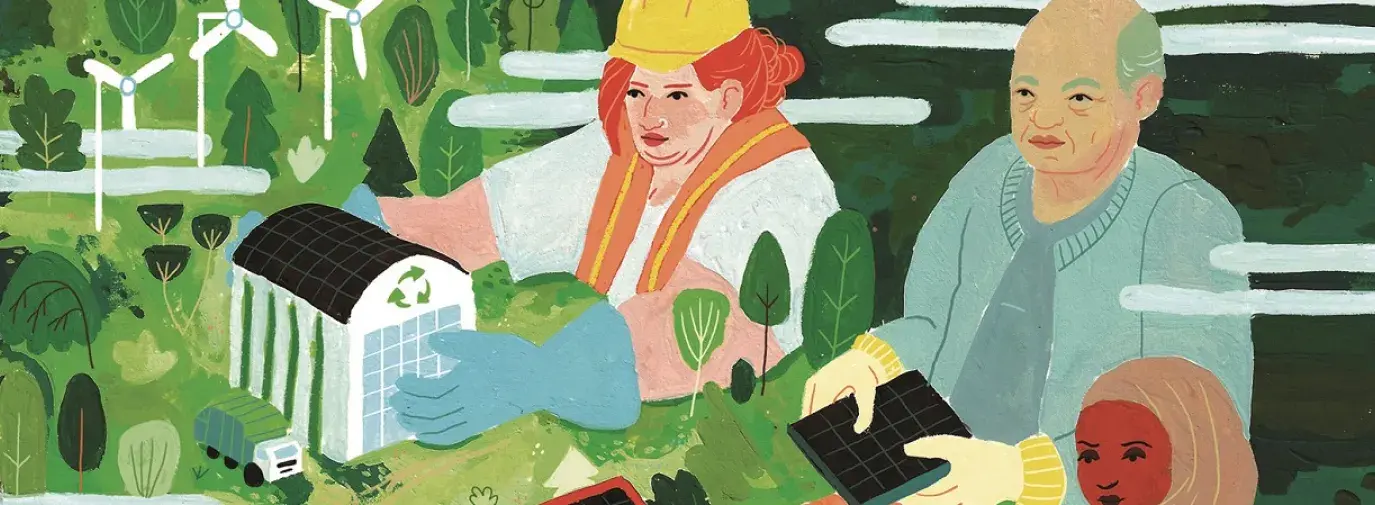
At Green America, we get asked if a green economy could really provide good paying jobs and careers. The answer is that several million people nationwide are already working in green jobs. What we tell naysayers is that there are companies big and small that are making their green dreams work—and growing the green economy by hiring more folks to help them.
The much-anticipated Green New Deal was introduced by Alexandria Ocasio-Cortez (D-NY), Ed Markey (D-MA), and other supporters in Congress in 2019. It failed to pass through the Senate, but the Green New Deal for Public Housing Act was reintroduced in March by Ocasio-Cortez, Sen. Bernie Sanders (D-VT) and Rep. Delia Ramirez (D-IL). We at Green America see our work and the work of our members in the Deal. .
What’s especially exciting is that as much as the Green New Deal was about desperately needed clean energy jobs, which we work for through campaigns like Hang Up on Fossil Fuels (see page 4), it’s about more than that. The Deal represents a massive investment in a green economy that can radically reduce climate emissions and enhance social justice. In that way, it’s a representation of what Green Americans have been working toward for decades.
You can see the social justice commitment in the Deal when it comes to fossil fuels. It’s easy to say that they should go away and make room for the clean energy revolution.
The reality is that many jobs in dirty energy, like oil, gas, and coal-fired power, are well-paying jobs that are unionized and provide benefits to workers—often in regions with depressed economies where good pay can be hard to come by, as illustrated in the piece “Bringing Renewables to Coal Country” (p. 22). Whether jobs are disappearing because of a transition to clean energy or because technological innovation removes the need for many workers, people rationally fear losing the paychecks and benefits they have. We must ensure that jobs created in the green economy are ones that pay well and provide opportunity for growth for diverse populations in all states, not just the few that are on stores of oil and coal.
The clean energy industry now employs over 40 percent of all energy workers in the United States, and demand has increased by more than 10 percent in the past two years, according to E2’s Clean Jobs America report from September 2023.
While industries and utilities are scaling up demand for clean energy, the small business sector has an important role to play in the green economy as well—approximately 61.7 million Americans worked in small businesses in 2023. Companies with under 500 workers (the definition of a small business), do outsized work driving innovation in our economy, by creating products, systems, and patents that start small and scale up across the supply chain. In this issue, you’ll meet small businesses from all over the country that are part of this green wave.
Importantly, the Green New Deal and green businesses must address the disparities of women and people of color working in green jobs (see letter on p. 30), especially in the clean energy industry. For the economy to be truly green, it must include everyone.
When Brandon Dennison was talking about what made him want to start a green jobs training program in the heart of Appalachia (p. 22), it wasn’t just about doing the “right,” green thing.
“I feel like a lot of the problem in Appalachia was that our economy was so based in extractive industries and that’s what got us to the stressed situation we’re in economically, socially, and environmentally,” Dennison says of why he decided to start an organization based specifically in green jobs. “We’re trying to model what a new and better and more sustainable economy could look like. There’s a social and environmental angle. I also think there are real business opportunities in the green economy, and so we’re trying to seize on those.”
Updated September 2024







